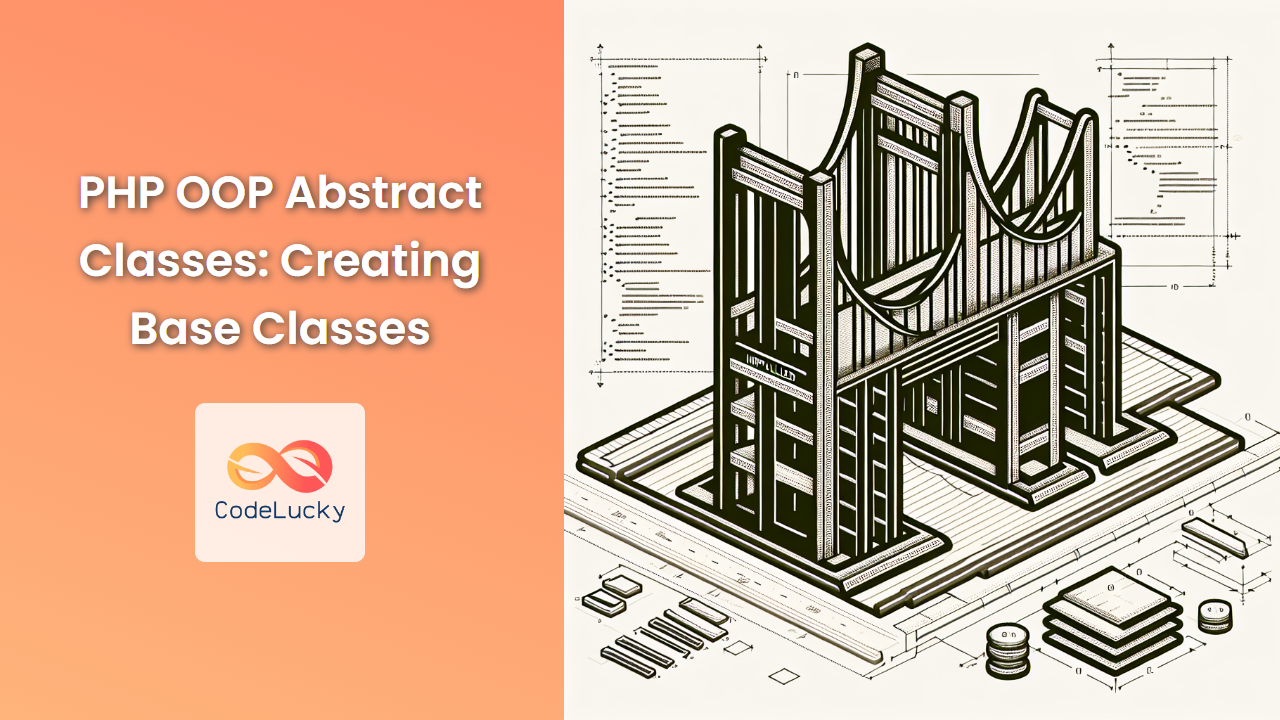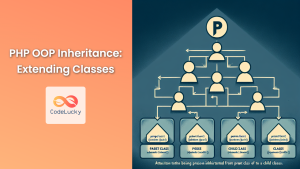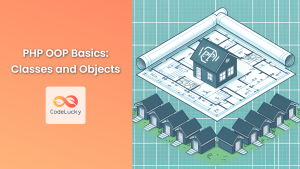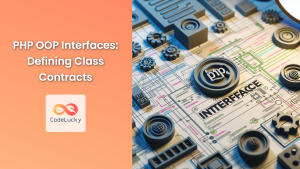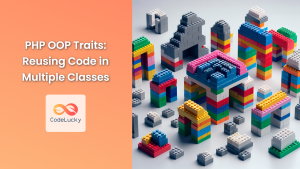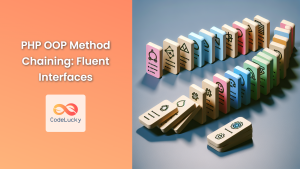In the world of Object-Oriented Programming (OOP), abstract classes serve as a powerful tool for creating robust and flexible code structures. PHP, being a versatile language, supports abstract classes, allowing developers to define base classes that can be extended by other classes. In this comprehensive guide, we'll dive deep into the concept of abstract classes in PHP, exploring their benefits, implementation, and best practices.
What are Abstract Classes? 🤔
Abstract classes are special classes that cannot be instantiated directly. They serve as a blueprint for other classes, defining a common structure and behavior that can be inherited by multiple subclasses. Think of an abstract class as a partially completed class that needs to be extended to create a fully functional object.
🔑 Key characteristics of abstract classes:
- Cannot be instantiated directly
- May contain abstract methods (methods without a body)
- Can have normal methods with implementation
- Can have properties (variables)
- Can have constructors
Why Use Abstract Classes? 🎯
Abstract classes offer several advantages in OOP:
- Code Reusability: Abstract classes allow you to define common methods and properties that can be shared across multiple subclasses.
- Enforcing a Common Interface: By defining abstract methods, you ensure that all subclasses implement certain methods.
- Providing a Base Implementation: You can include concrete methods in abstract classes, providing a default implementation that subclasses can use or override.
- Reducing Code Duplication: Instead of repeating common code in multiple classes, you can centralize it in an abstract base class.
Creating an Abstract Class in PHP 💻
Let's dive into some code! Here's how you can create an abstract class in PHP:
abstract class Shape {
protected $color;
public function __construct($color) {
$this->color = $color;
}
abstract public function getArea();
public function getColor() {
return $this->color;
}
}
In this example, we've created an abstract class called Shape. Let's break it down:
- The
abstractkeyword is used before theclasskeyword to declare an abstract class. - We have a protected property
$color. - There's a constructor that sets the color of the shape.
- The
getArea()method is declared as abstract, meaning it must be implemented by any class that extendsShape. - We also have a concrete method
getColor()that returns the color of the shape.
Extending an Abstract Class 🔗
Now, let's create some concrete classes that extend our Shape abstract class:
class Circle extends Shape {
private $radius;
public function __construct($color, $radius) {
parent::__construct($color);
$this->radius = $radius;
}
public function getArea() {
return pi() * $this->radius * $this->radius;
}
}
class Rectangle extends Shape {
private $width;
private $height;
public function __construct($color, $width, $height) {
parent::__construct($color);
$this->width = $width;
$this->height = $height;
}
public function getArea() {
return $this->width * $this->height;
}
}
Here, we've created two classes, Circle and Rectangle, both extending the Shape abstract class. Notice how:
- Both classes implement the
getArea()method, which was declared as abstract in theShapeclass. - They both call the parent constructor using
parent::__construct($color)to set the color. - Each class has its own specific properties (
$radiusfor Circle,$widthand$heightfor Rectangle).
Using the Abstract Class and Its Subclasses 🚀
Now that we have our abstract class and concrete subclasses, let's see how we can use them:
// Create instances of our shapes
$circle = new Circle("Red", 5);
$rectangle = new Rectangle("Blue", 4, 6);
// Use the getArea() method
echo "Circle Area: " . $circle->getArea() . "\n";
echo "Rectangle Area: " . $rectangle->getArea() . "\n";
// Use the getColor() method from the abstract class
echo "Circle Color: " . $circle->getColor() . "\n";
echo "Rectangle Color: " . $rectangle->getColor() . "\n";
Output:
Circle Area: 78.539816339745
Rectangle Area: 24
Circle Color: Red
Rectangle Color: Blue
This example demonstrates how we can create objects of the concrete classes and use both the methods defined in the abstract class (getColor()) and the methods implemented in the subclasses (getArea()).
Abstract Classes vs. Interfaces 🤼
While abstract classes and interfaces might seem similar at first glance, they serve different purposes:
| Abstract Classes | Interfaces |
|---|---|
| Can have both abstract and concrete methods | Can only have abstract methods (prior to PHP 8.0) |
| Can have properties | Cannot have properties (only constants) |
| A class can extend only one abstract class | A class can implement multiple interfaces |
| Can have a constructor | Cannot have a constructor |
| Used for creating a base class with some common functionality | Used for defining a contract that classes must adhere to |
Best Practices for Using Abstract Classes 📚
-
Use abstract classes for closely related classes: Abstract classes are best used when you have a set of closely related classes that share common functionality.
-
Keep it focused: An abstract class should have a clear, single responsibility. Don't try to cram too much functionality into one abstract class.
-
Use abstract methods judiciously: Only declare methods as abstract if you're certain that all subclasses should implement them.
-
Provide default implementations where possible: If a method can have a sensible default implementation, provide it in the abstract class rather than making it abstract.
-
Use abstract classes to define a template: The Template Method pattern is a common use case for abstract classes, where you define the skeleton of an algorithm in the abstract class and let subclasses override specific steps.
Real-World Example: Database Abstraction Layer 🗃️
Let's look at a more complex example of how abstract classes can be used in a real-world scenario. We'll create a simple database abstraction layer:
abstract class Database {
protected $connection;
protected $host;
protected $username;
protected $password;
protected $database;
public function __construct($host, $username, $password, $database) {
$this->host = $host;
$this->username = $username;
$this->password = $password;
$this->database = $database;
}
abstract public function connect();
abstract public function query($sql);
abstract public function close();
public function getLastError() {
return $this->connection->error;
}
}
class MySQLDatabase extends Database {
public function connect() {
$this->connection = new mysqli($this->host, $this->username, $this->password, $this->database);
if ($this->connection->connect_error) {
die("Connection failed: " . $this->connection->connect_error);
}
}
public function query($sql) {
return $this->connection->query($sql);
}
public function close() {
$this->connection->close();
}
}
class PostgreSQLDatabase extends Database {
public function connect() {
$dsn = "pgsql:host=$this->host;dbname=$this->database;user=$this->username;password=$this->password";
try {
$this->connection = new PDO($dsn);
} catch (PDOException $e) {
die("Connection failed: " . $e->getMessage());
}
}
public function query($sql) {
return $this->connection->query($sql);
}
public function close() {
$this->connection = null;
}
}
In this example:
- We have an abstract
Databaseclass that defines the basic structure for database connections. - The
MySQLDatabaseandPostgreSQLDatabaseclasses extend theDatabaseclass, implementing the specific methods for each database type. - The abstract class provides a common interface and some shared functionality (like
getLastError()), while the concrete classes handle the specifics of connecting to and querying different types of databases.
Here's how you might use these classes:
// Using MySQL
$mysql = new MySQLDatabase("localhost", "user", "password", "mydb");
$mysql->connect();
$result = $mysql->query("SELECT * FROM users");
// Process result...
$mysql->close();
// Using PostgreSQL
$postgres = new PostgreSQLDatabase("localhost", "user", "password", "mydb");
$postgres->connect();
$result = $postgres->query("SELECT * FROM users");
// Process result...
$postgres->close();
This abstraction allows you to switch between different database types easily, as they all follow the same interface defined by the abstract Database class.
Conclusion 🏁
Abstract classes in PHP provide a powerful way to create base classes that define a common structure for related classes. They allow you to share code, enforce a common interface, and provide default implementations where needed. By using abstract classes effectively, you can create more maintainable, flexible, and robust code structures in your PHP projects.
Remember, the key to using abstract classes effectively is to find the right balance between abstraction and concreteness. Use them when you have a clear hierarchy of related classes that share common functionality, but also need to implement specific behaviors.
As you continue to explore object-oriented programming in PHP, you'll find that abstract classes, along with interfaces and traits, form a powerful toolkit for creating well-structured, reusable code. Happy coding! 🚀👨💻👩💻
- What are Abstract Classes? 🤔
- Why Use Abstract Classes? 🎯
- Creating an Abstract Class in PHP 💻
- Extending an Abstract Class 🔗
- Using the Abstract Class and Its Subclasses 🚀
- Abstract Classes vs. Interfaces 🤼
- Best Practices for Using Abstract Classes 📚
- Real-World Example: Database Abstraction Layer 🗃️
- Conclusion 🏁

